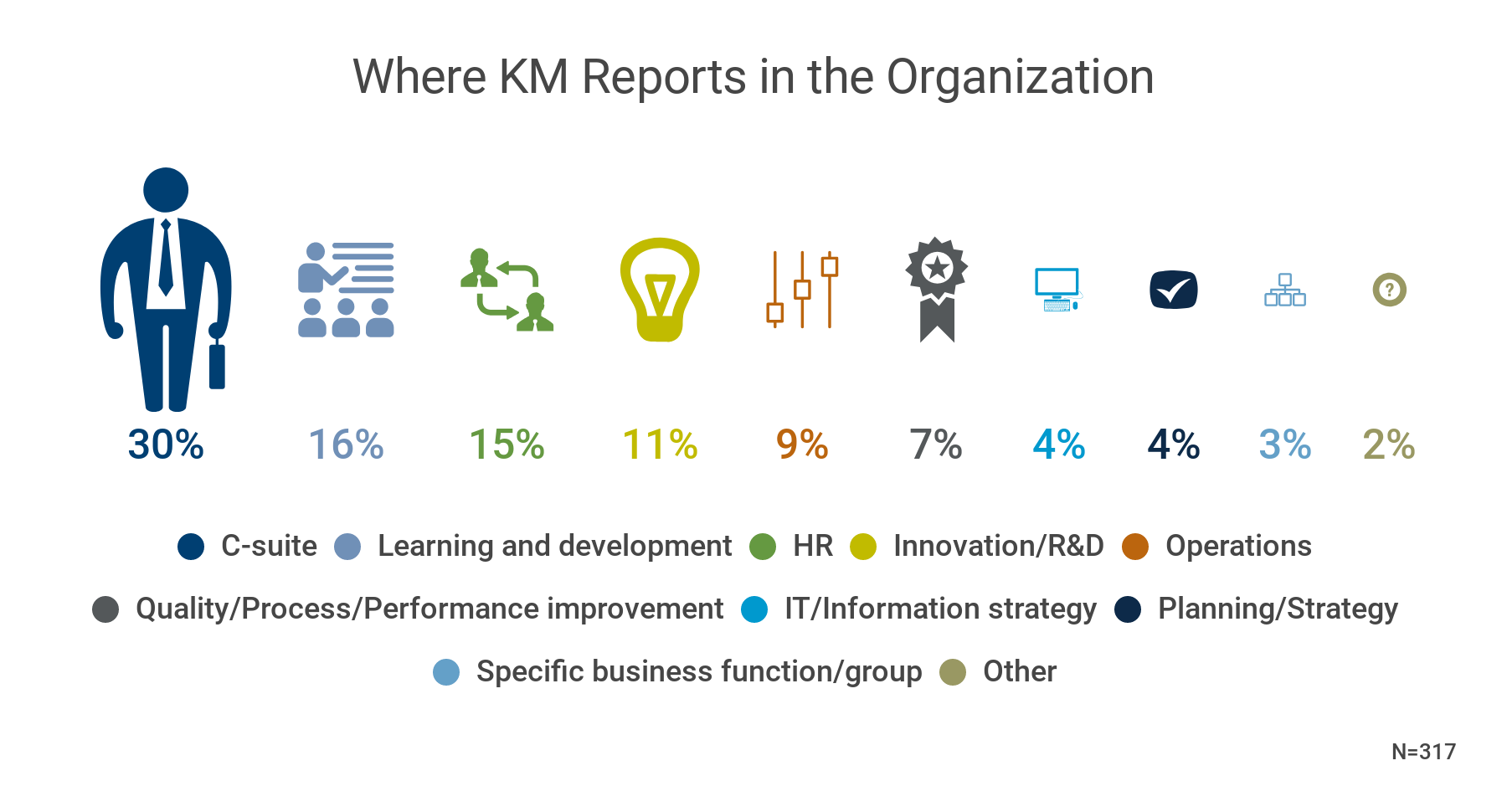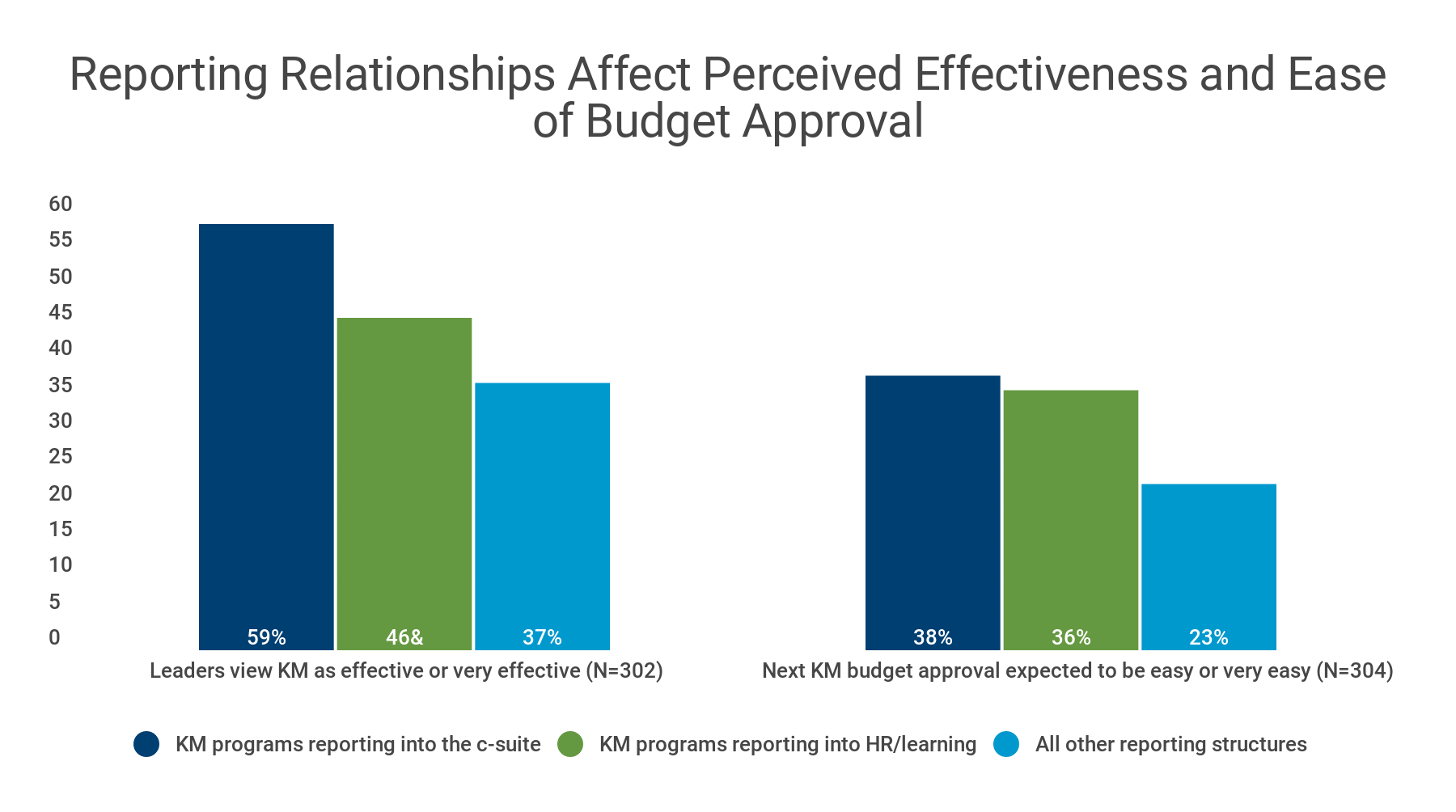Where should knowledge management sit on the org chart? I’ve been asked this question countless times, usually by KM leaders hoping to get their programs in front of the right influencers. My traditional answer is a little wishy-washy and boils down to: KM programs can—and do—report almost anywhere, and the best option depends on context.
It’s true that KM reporting structures vary widely, with successful programs reporting into every function from strategy to R&D, operations, HR, and IT. But analysis of data from APQC’s Open Standards Benchmarking® database offers additional insight into current reporting trends and the relative impact of different reporting relationships.
What the Data Says
APQC’s knowledge management metric of the month shows that a whopping 30 percent of KM programs report directly to a member of the c-suite such as the CIO or Chief Human Resources Manager. This may surprise knowledge managers in massive organizations who struggle to gain access and visibility to executives. But more than one-third of participating KM programs are in small and medium enterprises (under $1 billion revenue), many of which treat KM as a stand-alone discipline that answers directly to a senior executive. And even in larger organizations, KM may be taken on by a c-suite member who believes in its value and wants to further its success.
 Perhaps not surprisingly, KM programs with executive reporting relationships enjoy stronger support than those reporting into other parts of the business. For instance, these programs are 44 percent more likely to be seen as effective by leaders and 35 percent more likely to expect easy approval of their next KM budget. In some ways, the reasons for this are common sense. People support what they help create, so when senior executives directly oversee the KM program, they are more inclined to trust and champion it. But a direct link to the c-suite can also maximize KM’s impact by keeping it aligned with evolving strategic priorities.
Perhaps not surprisingly, KM programs with executive reporting relationships enjoy stronger support than those reporting into other parts of the business. For instance, these programs are 44 percent more likely to be seen as effective by leaders and 35 percent more likely to expect easy approval of their next KM budget. In some ways, the reasons for this are common sense. People support what they help create, so when senior executives directly oversee the KM program, they are more inclined to trust and champion it. But a direct link to the c-suite can also maximize KM’s impact by keeping it aligned with evolving strategic priorities.
Another 31 percent of KM programs report into either learning and development (16%) or HR (15%). These options have become increasingly common as firms recognize the affinities between KM, competency development, and workforce planning. Armed with new technology, corporate learning groups have shifted their focus from classroom training to just-in-time and personalized solutions. At the same time, firms are acknowledging the role of knowledge sharing and collaboration in employee retention, engagement, leadership development, and succession management. These changes bring the missions of learning, HR, and KM closer together and highlight the benefits of strong partnership.
While not quite as successful as programs that report into the c-suite, KM efforts that report to learning and HR enjoy higher levels of leadership confidence and easier budget approvals than most other programs. There are many possible reasons for this, but one is that executives inherently understand the purpose of HR and learning in terms of supporting career development and preparing employees for future roles. So when KM is presented as serving those goals (as well as the preservation of critical knowledge), it’s easier to get leaders on board and supporting the program.
 One of the biggest surprises in the data is that only 4 percent of participating KM programs report directly to IT or information strategy. Although we don’t have historical data for comparison, I suspect this number has gone down significantly over the past two decades. A good relationship with IT is crucial to help KM select the best tools and create a streamlined user experience across systems. But the fact that so few KM programs report into IT seems like a positive step in organizations recognizing that KM is about more than software.
One of the biggest surprises in the data is that only 4 percent of participating KM programs report directly to IT or information strategy. Although we don’t have historical data for comparison, I suspect this number has gone down significantly over the past two decades. A good relationship with IT is crucial to help KM select the best tools and create a streamlined user experience across systems. But the fact that so few KM programs report into IT seems like a positive step in organizations recognizing that KM is about more than software.
Acting on the Data
KM functions with c-suite reporting relationships achieve the best results, followed closely by those answering to learning or HR. But this doesn’t mean you should run out and change your reporting structure (which may not be in your control anyway). The best option will depend on:
- The reasons you created your KM program in the first place
- The target audience for your KM tools and approaches
- The knowledge problems you’re trying to solve
- Where in the organization you have the most active sponsorship
If your KM effort primarily supports R&D or engineering, for example, then it may make sense for it to be housed in that part of the business. And if a leader in operations or innovation is particularly passionate about the KM mission, you are probably better off reporting there than moving to a function where executives don’t (yet) understand or value what you’re trying to do.
Regardless of who you report to, look for executive champions across the enterprise who can advise you and advocate for your cause. Your leadership team or reporting relationship can change overnight, and your best defense is a diverse network of supporters who understand what KM brings to the table.